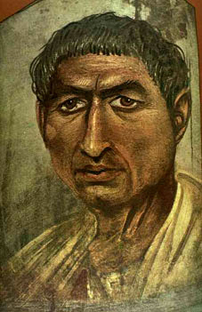
 |
|
 |
| Home |
| Background |
| Curriculum |
| The Schoolhouse |
| Teachers & Students |
| Apprenticeships |
| Artifacts |
| The Gymnasium |
| UM Papyrology Home |
| References |
| Credits |

| Teachers | |
 |
We can distinguish four types of teachers: (1) tutors
(pedagogues and kathegetai), (2) elementary teachers
(didaskaloi), (3) secondary teachers (grammatikoi),
and (4) teachers of rhetoric (sophistes and rhetores).
Tutors would meet with students in their homes. Elementary teachers
taught basic literacy, providing more instruction depending on the needs
of the student. Secondary teachers taught more advanced grammar and
literature. Teachers of rhetoric taught student to compose discourses
and to develop strong arguments. Though these distinctions can be drawn,
we often find teachers behaving in manner that crosses these boundaries.
For instance, a teacher in an Egyptian village might have had several
students of varying levels that he or she was instructing at the same
time. In this case the teacher is at once providing elementary instruction and secondary instruction to the more advanced students. A clever teacher might use this to his or her advantage by encouraging the more advanced students to help provide instruction to their less advanced fellow students. The social and economic standing of teachers varied widely even as it does today. For instance, a public school teacher providing instruction at a secondary level to children in inner-city Detroit is often considered less "prestigious" than a professor teaching at Princeton or Yale. While this may not be true, perception is often stronger than reality. Then as now, stature and social standing influenced the level of instruction that the teacher provided and the social and economic status of the students that he or she was educating. |
| Students | |
 |
Students in classrooms varied
widely in age and ability within the classroom. As can be expected,
there was also variation in how enthusiastic students might be about
their studies, dependent on the weather, the attitudes of their classmates,
and the disposition of their teacher. There is evidence of educated
young women, though the majority of schoolchildren were males. Additionally,
females were excluded from the study of rhetoric.
The text below, taken from a 9th-10th century textbook, paints a vivid picture of a student's experience: I went to school and I said, 'Greetings, teacher; greetings Instructor' and he greeted me in return. He gives me a manual and orders me to read five passages in his presence. I read accurately and well. Then I gave the manual to another. Next I went to the assistant teacher. I greet him and my fellow pupils, and they greeted me in return. Then I sat in my place on the bench... ...While I am sitting down, the slave who carries my school box hands me my little tablets and my writing case, my straight edge, my tablet and my lupines. I subtract, I do math, I compute, I count and I shall count, I add and subtract, I multiply, I divide... I cross out and I write an addition above the line, and I write and show it to my teacher. He praised me because I wrote well. I reread what I wrote word by word. I recite. I recited before you. Lies, I do not lie. 'If you speak truly', my pedagogue said to me, 'let us go home so we can go to the Greek and Latin teacher'. Then we were dismissed for sports, for Latin and Greek studies. We entered the school of the Greek teacher and the lecture room of the Latin teacher. I learn my texts thoroughly. If I am ready, I hand them in immediately. If not, I read them again... ...I took the text, verses, notes. The unknown book is explained to me, or the unknown passage. Explication is offered. I take my place, and others together with me read extemporaneously.; the rest repeat it accurately. The younger boys practice interpretation of the syllables, declensions, a lot of grammar, speech, all in front of the assistant teacher... ...The older boys go to the teacher, they read a text about the Iliad, another about the Odyssey. They take up a theme, a hortatory speech, a debate, history, comedy, narratives, every kind of oration, causes of the Trojan war... (Rowlandson, Women & Society in Greek & Roman Egypt, pp. 305 & 306, text 238) |
| Image credits: | |
1. Image after Bowman, A.K., Egypt after the Pharaohs, Oxford 1990. |
|